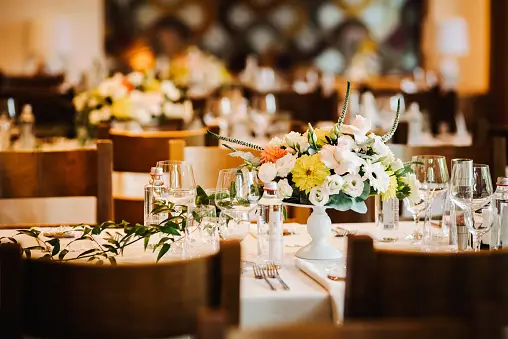“Ikeria: The Art of Flower Arrangement”
Uncategorized Uncategorized
Ikeria: The Art of Flower Arrangement:
Introduction:
The art of flower arrangement, known as “Ikeria,” has a rich history and a profound impact on cultures worldwide. It involves the careful selection, placement, and composition of various flowers, leaves, and other natural elements to create harmonious and visually appealing displays. Ikeria is much more than a mere decorative craft; it’s a timeless art form that speaks to our senses and emotions, evoking feelings of beauty, serenity, and connection to nature. In this blog, we will delve into the fascinating world of Ikeria, exploring its history, techniques, and the enduring allure it holds for flower enthusiasts and artists.
Ikeria: A Time-Honoured Tradition-The practice of Ikeria, or flower arrangement, has ancient roots in various cultures, each contributing to its unique development and style. While it is closely associated with Japanese Ikebana, the art of flower arrangement is by no means confined to Japan. Ikeria is a reflection of the human desire to connect with nature and express creativity through the medium of flowers. It has evolved over the centuries and continues to inspire people worldwide.
Ikeria Around the World–
- Ikebana in Japan:
Ikebana, the traditional Japanese art of flower arrangement, dates back to the 6th century when it was introduced to Japan by Chinese Buddhist monks. Ikebana emphasizes simplicity, harmony, and minimalism. The arrangement often consists of three primary elements: the Shin (heaven), the Soe (earth), and the Hikae (man). Each flower and branch is carefully selected and placed to create a balanced and expressive composition.
- European Floral Design:
Europe boasts a rich tradition of floral artistry, with countries like the Netherlands renowned for their intricate floral displays. The European approach often leans towards lush, full arrangements, utilizing a wide variety of flowers, foliage, and decorative elements. These arrangements are typically used for special occasions, such as weddings and formal events.
- Thai Floral Art:
In Thailand, flower arrangements are an integral part of cultural traditions and rituals. These arrangements, often made using tropical flowers and leaves, are employed in religious ceremonies, festivals, and daily life. Thai flower art captures the essence of the country’s vibrant and exotic flora.
- Chinese Flower Arrangement:
China has a rich history of floral art, with techniques that reflect a deep connection to the natural world. Traditional Chinese flower arrangements feature symbolism and convey profound meanings. Certain flowers and colours are chosen to express specific sentiments or wishes.
- Contemporary Floral Art:
In contemporary times, flower arrangement has evolved into a diverse and creative field. Artists and floral designers worldwide have pushed the boundaries of tradition, experimenting with styles that blend classical principles with modern influences. This approach has resulted in innovative and expressive arrangements that continue to captivate audiences.
Ikeria: A Journey of Creation and Expression
At its core, Ikeria is a practice that invites individuals to engage with nature’s beauty and craft arrangements that evoke emotions, tell stories, and bring serenity. Creating a flower arrangement is a multi-faceted process that requires a deep understanding of flowers and their characteristics, as well as the application of design principles to create a visually pleasing composition. Let’s delve into the various elements that make up this intricate art.
- Selection of Materials:
The first step in Ikeria is choosing the right materials. This includes selecting flowers, foliage, branches, and any other natural elements that will be part of the arrangement. Considerations include color, texture, shape, and size.
- Vessel Choice:
The vessel or container in which the arrangement will be placed is a crucial element. It should complement the chosen materials and contribute to the overall aesthetic. Vessels can range from simple and understated to ornate and decorative.
- Design Principles:
A successful flower arrangement follows design principles such as balance, proportion, contrast, rhythm, and harmony. Achieving a sense of balance and harmony is especially important in Ikeria, as it conveys the desired emotions and aesthetics.
- Techniques:
Ikeria involves several techniques, such as line, balance, harmony, unity, and emphasis. These techniques guide the placement of materials within the arrangement. For example, the line technique focuses on the flow and direction of the materials, while balance ensures that the composition is visually stable.
- Symbolism and Meaning:
In some forms of Ikeria, symbolism plays a significant role. Flowers and elements are chosen not only for their visual appeal but also for the emotions and messages they convey. For instance, red roses may symbolize love, while white lilies represent purity.
- Emotion and Expression:
Ikeria is an art form that allows for personal expression and emotion. Artists and arrangers can use the medium of flowers to convey feelings, stories, or moods. This emotional connection is a fundamental aspect of the art.
The Universality of Ikeria
One of the remarkable qualities of Ikeria is its universal appeal. While it has deep roots in various cultures, it transcends boundaries and is cherished by people worldwide. The beauty of flowers and the art of arranging them are universally understood and appreciated. Ikeria speaks a universal language of beauty, nature, and human creativity.
Ikeria in Modern Times
In contemporary society, Ikeria remains a relevant and influential art form. It has adapted to changing times, and its principles are applied not only in traditional arrangements but also in various aspects of life. Here are some ways in which Ikeria continues to flourish in the modern world:
- Floral Design and Interior Decor:
Flower arrangements are frequently used to enhance the interior decor of homes, businesses, and event venues. Floral designers play a crucial role in creating arrangements that reflect the desired ambiance and style.
- Weddings and Special Events:
Weddings and special events often feature elaborate floral arrangements. From bouquets to centrepieces, flowers are an integral part of celebrations, adding elegance and romance to the occasion.
- Therapeutic and Healing Uses:
The therapeutic benefits of Ikeria are increasingly recognized. Floral therapy, or “flower healing,” involves using flower arrangements to enhance emotional well-being and promote relaxation.
- Education and Appreciation:
Educational programs and courses on Ikeria are widely available. These programs offer enthusiasts and budding artists the opportunity to learn about the art form’s history, techniques, and principles.
- Cultural and Religious Significance:
Ikeria remains an essential component of cultural and religious rituals and ceremonies in many parts of the world. It is used to pay homage to deities, celebrate festivals, and honor traditions.
Ikeria: A Source of Inspiration
Flower arrangements have the power to inspire and uplift. The simple act of arranging flowers can bring joy, beauty, and a sense of connection to the natural world. Ikeria encourages us to appreciate the small wonders of the world around us and to express our creativity through nature’s bountiful palette.
Floral artistry provides a unique way to connect with the changing seasons, celebrate life’s milestones, and convey sentiments to loved ones. The act of giving or receiving a well-crafted flower arrangement is a cherished tradition that symbolizes love, appreciation, and remembrance.
Ikeria also serves as a reminder of the impermanence of life. Flowers, with their fleeting beauty, remind us to savor the present moment and find beauty in the transient nature of existence. In this way, Ikeria is not just an art form; it is a philosophy that encourages us to find beauty in all stages of life, even in its ephemerality.
The Future of Ikeria
The art of flower arrangement, or Ikeria, continues to evolve and adapt to the changing times. With the advent of new floral varieties, innovative techniques, and sustainable practices, Ikeria remains a vibrant and relevant art form. The digital age has allowed enthusiasts to share their creations with a global audience, inspiring new generations to explore the world of flower arrangement.
In an era where nature’s beauty is increasingly appreciated for its healing and soothing qualities, Ikeria is poised to play a pivotal role. Its ability to bring the outdoors inside and create tranquil, harmonious spaces makes it a valuable art form for a world that often seeks solace in nature’s embrace.
As we move forward, the principles and techniques of Ikeria will continue to guide those who seek to express their creativity through flowers. Its universal appeal and enduring beauty will ensure that Ikeria remains a beloved and cherished art form for generations to come.
Conclusion: The Timeless Beauty of Ikeria
In the art of flower arrangement, we find a profound connection to nature, an avenue for creative expression, and a source of inspiration. Ikeria, with its diverse cultural influences and universal appeal, is a testament to the enduring beauty of flowers and the human desire to connect with the natural world.
Whether used in traditional ceremonies, modern events, or daily life, flower arrangements bring beauty and joy to our world. They serve as reminders of life’s impermanence and the importance of savouring each moment. In the hands of skilled arrangers and enthusiasts, flowers are transformed into works of art that speak to our hearts and souls, offering solace and beauty in a complex and ever-changing world.

Sutanaya Dutta
Assistant Professor, Hospitality and Hotel Management
Geeta University, Panipat
B. Tech Computer science engineering:
Best specialization to choose for B. Tech CSE:
These days, the need for artificial intelligence and machine learning is rising quickly, and so is the
specialisation of this subject all over the world. Programming language, neural networks, human
intelligence, and other topics will be more heavily studied in this specialisation in data science and
machine learning. After completing this, you will have a tonne of employment options, including those
for data analysts, research scientists, AI engineers, machine learning engineers, data miners, etc.
IoT – IoT (Internet of Things) is concerned with the things or devices that can be managed through the
internet from your mobile device over a wifi connection, be it your appliance, televisions, AC, etc. This
field is expanding quickly due to advancing technology. We have a tonne of opportunities thanks to the
Internet of Things for the future, including the following:
- Data scientis
- Network Engineer
- Information security engineers
- Embedded program engineers
- Hardware engineer
Due to the advent of IoT, engineering today has various advantages in a variety of industries to work in,
including software development and electrical and electronic products.
Conclusion:
Related Posts
Improving Learning with Effective Teaching Pedagogy
Effective teaching pedagogy plays a critical role in today’s changing educational scene. Pedagogy, or the art and science of teaching, refers to a variety of tactics, methods, and approaches designed to facilitate learning and nurture student growth. This blog will

Nanotechnology in Drug Delivery system
Introduction: Drug development and delivery encompass the process of discovering, developing, manufacturing, and administering therapeutic agents to treat or prevent diseases. It involves interdisciplinary collaboration among scientists, clinicians, regulatory agencies, pharmaceutical companies. Nanotechnology has revolutionized drug delivery by offering solutions
AI-Powered Legal Document Analysis and Contract Review
In today’s fast-paced, digitally-driven legal landscape, the integration of Artificial Intelligence (AI) into legal practices has revolutionized how professionals manage, interpret, and analyze legal documents. Legal document analysis and contract review are integral to law firms, corporate legal departments, and


